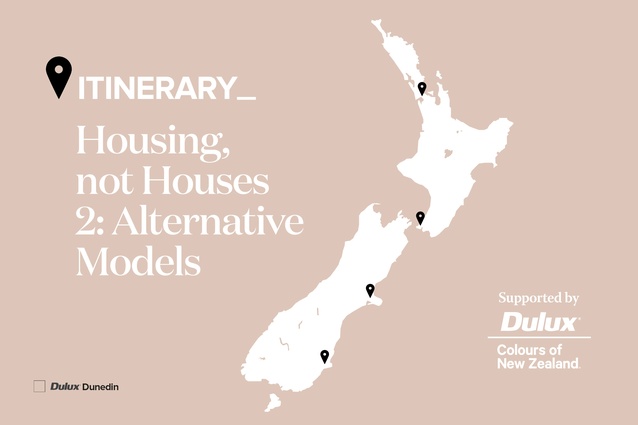Itinerary_ Housing, not Houses 2: Alternative Models
In this month’s Itinerary, supported by Dulux Colours of New Zealand, Julia Gatley and Andrew Barrie continue their discussion on increased housing density, focusing on 14 projects that highlight the alternative approaches to apartment buildings.
Our last Itinerary, in Architecture NZ’s September/October issue, recognised the benefits of increased housing density. This one continues that discussion, but with a shift in focus to emphasise the breadth of development and procurement models apparent today. New Zealand’s raft of housing supply and quality issues will never be solved by the speculative market alone. The primary drivers for the expansion in approaches are often cost reduction and increased affordability and equity, while maintaining indoor environmental comfort, but other considerations include the choice to live more communally, the desire for security of tenure and a commitment to environmental sustainability.
Central government has been building state rental housing at densities higher than detached and row or terrace housing since the late 1930s. Its prototypes, the Centennial Flats (1938–1940) and Dixon Street Flats (1940–1944), are in Wellington and both are now Category 1 historic places. Auckland and Wellington City Councils also became important providers of public housing in the post-war period: Auckland most famously with terrace housing and star flats in Freemans Bay, and Wellington with a series of large blocks in Mount Cook and Newtown.
This century, Kāinga Ora has demonstrated a commitment to densifying many of its older housing areas — albeit without due regard for the heritage value of the existing buildings, in some cases. The agency has been working closely with local authorities and private partners to facilitate development and construction. Its recent use of offsite and modular construction has the potential to be transformational for the construction sector but, given the current National-led Coalition’s slashing of public-sector budgets, there is the potential for knowledge and momentum to be lost.
Perhaps most encouraging right now is the private sector’s embrace of build-to-rent housing. There is so much to celebrate in this approach, starting with the commitment to building well in the first place, in order to minimise future maintenance costs. The long-term view is important, not only in terms of maintenance and repair but also because it opens up the possibility of longer tenancies, giving occupants security, stability and a sense that the place in which they live really is their home.
Individuals wanting to own their own homes but disillusioned by market prices have pursued other options, notably cohousing, in which groups of people pool resources to reduce development costs through economies of scale and then live more communally by sharing amenities, such as the land, gardens, laundries, bike sheds and a limited number of cars.
Papakāinga, developed by iwi or hapū for their members, also combine private homes with communal amenities. Until recently, new papakāinga developments typically comprised individual houses, often single storeyed, but this is starting to change. Anahera Rawiri, Rau Hoskins and Irene Kereama-Royal call the new typology vertical papakāinga. They explain that for Māori, having people living above other people’s heads was traditionally understood to be tapu. Their research suggests that this is less of an issue when all are whānau and that vertical papakāinga provide increased potential for progression from renting to equity sharing and, ultimately, home ownership.
Finally, New Zealand has a growing number of community housing providers. The term community housing encompasses various types of facilities, which operate independently of government and on a not-for-profit basis, motivated by a belief that the public sector is not doing enough to house society’s most vulnerable. Providers often access some central government support, including grants and loans from the Housing Innovation Fund and subsequent Social Housing Fund.
In housing, one size does not fit all. The sector is diversifying and the various models are all welcome in a time of such widely recognised need.
THE ITINERARY
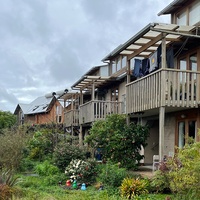
1. 1999–2008, Earthsong Eco-Neighbourhood
457 Swanson Road, Rānui, Auckland
Robin Allison
Earthsong is a 32-home cooperative housing development in west Auckland. Architect Robin Allison’s brainchild, it was premised on community and permaculture living. In the early 1990s, Allison started talking to potential collaborators and researching precedents and local authority requirements. The complex comprises a shared building for community get-togethers, unit-titled homes in short rows, well-established productive gardens, an orchard and native trees, and grouped carparking. Earth building, passive solar gain, solar hotwater heating and rainwater use were important considerations. See Robin Allison, Cohousing for Life (2020).
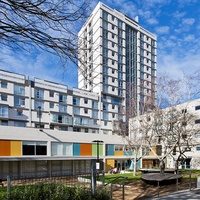
2. 2007–2015, Wellington City Council Housing
Various addresses
Various architects
Wellington City Council is our second-largest social housing provider, after Kāinga Ora. Its more recent work includes the upgrade of multiple 1960s’ and 1970s’ blocks. Among these are: Novak+Middleton’s upgrade of Te Ara Hou Apartments, Constable Street (NZIA Local Award, 2010), and Central Park Apartments, Nairn Street (NZIA New Zealand Award, 2014); and Studio Pacific Architecture’s upgrade of the Newtown Park Flats, Mansfield Street (NZIA Local Award, 2013). New builds include Designgroup Stapleton Elliott’s Regent Park Apartments, Owen Street (NZIA New Zealand Award, 2013), and Marshall Court Apartments, Tahi Street (NZIA New Zealand Award, 2015).
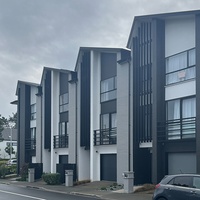
3. 2011–ongoing, Hobsonville Point
Hobsonville, Auckland
Various, including Isthmus Group and Construkt Architects
Hobsonville Point has been described as the country’s biggest master-planned residential development. The former Defence Force airbase was developed from scratch by the Hobsonville Land Company, established in 2006 as a subsidiary of Housing New Zealand Corporation. It comprises some 4500 homes, many of them now privately owned, from houses and duplexes to terrace housing and larger apartment buildings, by a raft of leading architectural practices. Amenities include parks, playgrounds, cycling and walking routes, cafés, restaurants and day care for children, provided to enhance liveability and a sense of community.
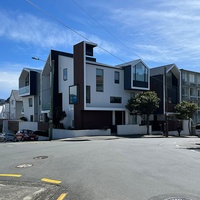
4. 2015, Zavos Corner Apartments
76 Brougham Street, Mount Victoria, Wellington
Parsonson Architects
Zavos Corner is an early example of what is now a wave of build-to-rent apartment schemes. The eight-unit complex was developed by a couple with long-standing family connections to the site. It is a delight. In a cottagey neighbourhood, but with a Modernist apartment building to its north, it meets the challenge of being both contextual and contemporary at the same time, with small-scale elements in the Athfield-Walker tradition, notably various cottage-like projections. In 2016, it was the first multi-unit scheme to earn the NZIA’s Sir Ian Athfield Award for Housing and was also HOME magazine’s Home of the Year. See Architecture NZ Nov/Dec 2016.
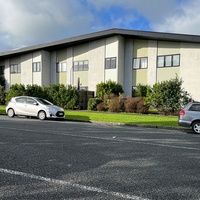
5. 2016, Kāinga Tuatahi
144–154 and 155–165 Kupe Street, Ōrākei, Auckland
Stevens Lawson Architects
Kāinga Tuatahi has been described as the first medium-density papakāinga, built to provide affordable quality housing for Ngāti Whātua Ōrākei members and whānau. The hapū retains ownership of the land and sells the two-, three- and four-bedroom homes to hapū members and whānau on a leasehold basis. The 30 homes span both sides of Kupe Street, grouped together under gabled roofs that Stevens Lawson describes as korowai (cloaks). Kāinga Tuatahi includes shared outdoor facilities, such as barbecue and play areas and vegetable gardens. It earned an NZIA Local Award in 2017. See Architecture NZ Sept/Oct 2018.
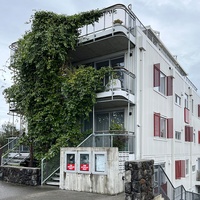
6. 2016–2020, 26 Aroha
26 Aroha Avenue, Sandringham, Auckland
Jasmax
26 Aroha is build-to-rent and exemplifies a commitment to environmental sustainability. The 13-unit, three-car-park scheme is 9 and 10 Homestar rated, with Stonewool insulation, rainwater collection, solar power and hot water, roof-top laundry facilities, a shared electric car, storage space for bikes and scooters, charging points for e-bikes and a communal food garden. Christopher Kelly identifies it as “the first THAB off the rank (haw)” and suggests Auckland Council should have used it as a poster-child for increased density in Terrace Housing and Apartment Buildings Zones. It earned an NZIA Local Award in 2021. See Architecture NZ Nov/Dec 2020.
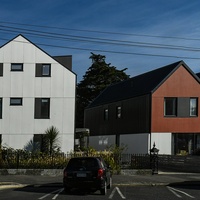
7. 2018–2020, Toiora High Street Cohousing
Corner Alva and High Streets, Dunedin
Architype
Toiora is understood to be New Zealand’s first certified passive house cohousing scheme. Its 21 homes combine triple glazing, thick walls, and a high degree of insulation and airtightness with passive house mechanical ventilation, keeping interiors at 20 to 22 degrees throughout the year. Two rows with homes of varying size (up to five bedrooms) are at right angles to each other, framing a communal garden. The site was formerly home to a school, part of which was retained to serve as a community centre with a dining area and meeting rooms. The scheme earned an NZIA Local Award in 2023. See Architecture NZ Jul/Aug 2023.
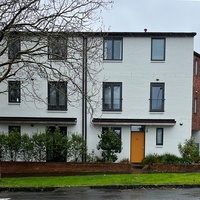
8. 2018–2021, Cohaus
11 Surrey Crescent, Grey Lynn, Auckland
Studio Nord
In producing perhaps our most discussed recent cohousing project, the architects were central to forming a group of 20 families to fund and occupy its terrace houses and apartments. Occupants share a range of facilities, notably a common garden and ‘garden house’. Awarding an NZIA Local Award in 2023, the jury was effusive: “The understated street presence of Cohaus conceals a rich internal complexity and a tight-knit community. The result is a new typology for medium-density housing in Aotearoa New Zealand… [which] establishes a new bar to which future multi-unit projects should aspire.” See Architecture NZ Nov/Dec 2021.
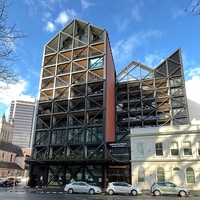
9. 2007–2022, HomeGround
140 Hobson Street, Auckland
Stevens Lawson Architects
This competition-winning design for the Auckland City Mission, Te Tāpui Atawhai, takes award-winning architecture to Central Auckland’s homeless. It is home to 80, many in 30-square-metre bedsits. Gables refer to churches and wharenui, while the structural steel exoskeleton is like an abstract tukutuku panel. Cross-laminated and other timbers are used elsewhere. HomeGround’s front desk and support facilities are on a pedestrian laneway through the building, connecting Hobson and Federal Streets. The project earned the NZIA’s John Scott Award for Public Architecture in 2022. See Simon Wilson, HomeGround (2022).
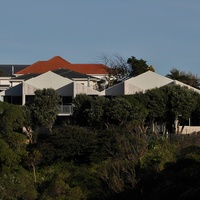
10. 2022, Block Party
Southgate, Wellington
Spacecraft
Designed by a young firm with a string of modest but adventurous single family houses, this project demonstrates how well cohousing might deliver for those not well served by the property ladder. Built for a crew of friends, these four two-bedroom units show how clever design can bring liveliness and generosity, even in compact spaces. Robust materials, considered details and individualised colour schemes animate the units. The bravura moment is on the street frontage: a large party deck and common social space enclosed in polycarbonate. Straightforward to the point of audacity, this design shows modest means need not limit ambition. See Architecture NZ May/June 2023.
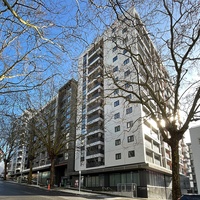
11. 2019–2023, Te Mātāwai
139 Greys Avenue, Auckland
MODE Design Corp
Te Mātāwai replaces the old Upper Greys Avenue Flats (1954–1959), a building much like Wellington’s Gordon Wilson Flats in form and spatial planning. It is unfortunate that Kāinga Ora could not adapt the old flats to work for today’s inner-city state housing tenants. The new facility more than trebles the number of units, mixes public and private tenants (70 per cent to 30 per cent) and includes ‘wraparound support’ and health services for those who need them. When Bill McKay reviewed it, he concluded that it is well planned, well finished and warm: “I’d live here.” It earned an NZIA Local Award in 2024. See Architecture NZ Nov/Dec 2023.
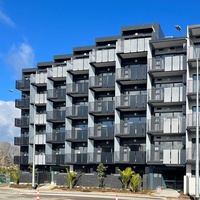
12. 2021–2023, 22–24 Point Chevalier Road
Point Chevalier, Auckland
Tawera Group and Paul Brown & Associates
This is one of a number of Kāinga Ora projects utilising modular construction with a view to speeding up construction while also decreasing the cost of it. More than 60 single-bedroom apartments have replaced eight houses, including one destroyed by fire. The apartments were built off site as modules or pods, complete with kitchens and bathrooms. In theory, such buildings can be built in less than 12 months. Various local and overseas companies are building the pods. Those in the Point Chev project were imported from China by Tawera Group, which specialises in modular construction.
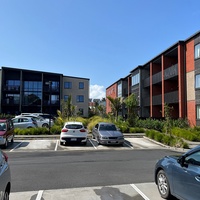
13. 2022–2023, Kupenga Apartments
Various addresses, Point England, Auckland
Brewer Davidson
Kupenga was the first in Simplicity Living’s burgeoning build-to-rent portfolio. The company is part of Simplicity, a not-for-profit KiwiSaver fund manager, and works as investor, developer, builder, owner and property manager to produce warm, dry, long-lasting rental homes. It increases efficiencies and reduces construction waste by using modular design and standardised dimensions and componentry, including prefabrication where practicable, with subtle variations in individual complexes. It is committed to looking after its buildings and, commendably, has enabled longterm tenants to have their rental increases pegged to inflation.
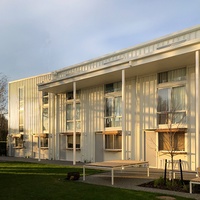
14. 2023, Oxford Terrace Baptist Church Housing
288 Oxford Terrace, Christchurch
Andrew Barrie Lab
Churches have long been providers of housing but this ’quake rebuild takes the extra step of seeking to create a community encompassing all aspects of daily life. Perhaps unsurprisingly, the project follows a monastic model, with a set of two-, four- and five-bedroom apartments being added to a 2018 building containing church spaces, parish social facilities and social service agency offices. The buildings are arranged around a cloister, with all amenities looking onto and accessed from this common space. A last block containing housing and further social spaces will soon complete the complex. See Architecture NZ Jan/Feb 2020.
OTHER ADDRESSES
2015–2016, Te Aro Pā Papakāinga
312 Evans Bay Parade, Hataitai, Wellington
Walker Architecture & Design
A collaboration between Dwell Housing Trust, Ngāti Ruanui and Taranaki iwi.
NZIA Local Award, 2018.
2017–2020, Waterview Court
Great North Road, Waterview, Auckland
Ashton Mitchell
120 units for Kāinga Ora.
NZIA National Award, 2021.
2018–2020, Westlight Apartments
6–8 Waikumete Road, Glen Eden, Auckland
MC2 Architects
2020, Rangiora Housing
High and White Streets, Rangiora
Rohan Collett Architects
28 units for Kāinga Ora.
NZIA National Award, 2021.
2020, Modal
845 New North Road, Mount Albert, Auckland
Ockham Residential
Ockham’s first build-to-rent.
2021, Kōtukutuku Papakāinga
16–20 Franklyne Road, Otara, Auckland
TOA Architects
For the Mahitahi Trust.
2020–2023, Moroki
46–50 Line Road, Glen Innes, Auckland
Construkt Architects
A build-to-rent scheme from New Ground Living and iwi collective, Hāpai.
2022–2024, Elevation
205–211 Lake Road, Northcote, Auckland
TLC Modular
Two modular blocks, built with pods imported from Vietnam.
SOURCES
Two of the schemes in this itinerary have each been the subject of a dedicated monograph: Robin Allison, Cohousing for Life: A Practical and Personal Story of Earthsong Eco-Neighbourhood (Auckland: Mary Egan, 2020); and Simon Wilson, HomeGround: The Story of a Building that Changes Lives (Auckland: Massey University Press, 2022). Other useful titles include: Karen Witten, Wokje Abrahamse and Keriata Stuart, Growth Misconduct? Avoiding Sprawl and Improving Urban Intensification in New Zealand (Auckland: Steele Roberts Aotearoa, 2011); Sarah Bierre, Philippa Howden-Chapman and Lisa Early (eds.),Homes People Can Afford: How to Improve Housing in New Zealand (Wellington: Steele Roberts Aotearoa, 2013); James Brown, Tenants, Tenacity, Troubles and Triumph: Dwell Housing Trust; More than a Landlord, 1981–2001 (Wellington: Dwell Housing Trust, 2021); and Fiona Cram, Jessica Hutchings and Jo Smith (eds.), Kāinga Tahi, Kāinga Rua: Māori Housing Realities and Aspirations (Wellington: Bridget Williams Books, 2022). The provider websites are also useful sources.

The Itinerary series is supported by Dulux Colours of New Zealand. Dulux Colour Specialist Davina Harper has selected a Colours of New Zealand palette based on this itinerary. See the full range and order colour samples here.


